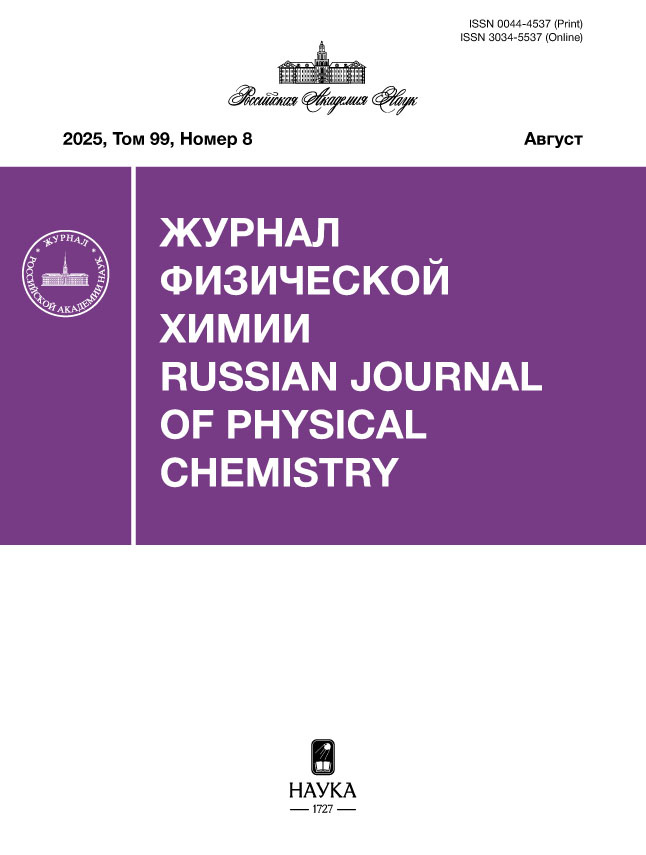Hydrogen Production from Oxalic Acid on Tantalum-Containing Composites under Irradiation UV and Visible Light
- 作者: Skvortsova L.N.1, Tatarinova T.V.2, Artyukh I.A.1, Bolgaru K.A.2
-
隶属关系:
- National Research Tomsk State University
- FGBUN Tomsk Scientific Center SB RAS
- 期: 卷 99, 编号 8 (2025)
- 页面: 1272-1282
- 栏目: PHOTOCHEMISTRY, MAGNETOCHEMISTRY, MECHANOCHEMISTRY
- ##submission.dateSubmitted##: 06.11.2025
- ##submission.datePublished##: 15.08.2025
- URL: https://edgccjournal.org/0044-4537/article/view/695902
- DOI: https://doi.org/10.7868/S3034553725080206
- ID: 695902
如何引用文章
详细
The photocatalytic activity of iron-containing composites based on silicon nitride, obtained in the combustion mode of ferrosilicon aluminum (FSA) with various Ta additives (5, 10, 15%), was investigated for hydrogen production from aqueous solutions of H2C2O4 under UV and visible light irradiation. X-ray diffraction method revealed that the main phases of the ceramic matrix of the composites are β-Si3N4 and α-Fe, along with the presence of the semiconductor phase TaON. The morphological features of the samples were studied using electron microscopy. The composite synthesized from FSA with 10% Ta exhibited the highest photocatalytic activity, attributed to its optimal composite structure of Si3N4-TaON-Fe. The mechanisms of H2C2O4 adsorption and photocatalytic generation of H2 from H2C2O4 were investigated on Ta-containing composites synthesized from FSA and a mixture of elemental powders (silicon, aluminum) with 10% Ta in the absence and with the addition of H2O2. It was established that the dependence of photocatalytic H2 evolution on the concentration of H2C2O4 allows the use of the Langmuir-Hinshelwood model. The highest H2 generation rate (6.34 μmol∙min–1) from H2C2O4 is achieved in the presence of H2O2 on the iron-containing composite, which is due to the participation of both heterogeneous and homogeneous photocatalytic processes.
作者简介
L. Skvortsova
National Research Tomsk State University
Email: lnskvorcova@inb ox.ru
Tomsk, Russia
T. Tatarinova
FGBUN Tomsk Scientific Center SB RASTomsk, Russia
I. Artyukh
National Research Tomsk State UniversityTomsk, Russia
K. Bolgaru
FGBUN Tomsk Scientific Center SB RASTomsk, Russia
参考
- Ashfaq Z., Iqbal T., Ali H. et al. // Arab. J. Chem. 2023. V. 16. № 9. P. 105024. https://doi.org/10.1016/j.arabjc.2023.105024
- Джабиев Т.С., Авдеева Л.В., Савиных Т.А., Джабиева З.М. // Журн. физ. химии. 2022. Т. 96, № 1. С. 138. [Dzhabiev T.S, Avdeeva L.V., Savinykh T.A., Dzhabieva Z.M. // Russ. J. Phys. Chem. A. 2022. V. 96. № 1. P. 216. https://doi.org/10.1134/S0036024422010071]. doi: 10.31857/S0044453722010071
- Ullah H., Asif Ali T., Salma B., Tapas K.M. // Appl. Catal. B Environ. 2018. V. 229. P. 24. doi: 10.1016/j.apcatb.2018.02.001
- Hitoki G., Ishikawa A., Takata T., N Kondo J. et al. // Chem. Lett. 2002. V. 31. № 7. P. 736. https://DOI.org/10.1246/cl.2002.736
- Kasahara A., Nukumizu K., Hitoki G., Takata T. // J. Phys. Chem. A. 2002. V. 106. № 29. P. 6750. doi: 10.1021/jp025961+
- Matoba T., Maeda K., Domen K. // Chem. Eur. J. 2011. Vol. 17, № 52. P. 14731. https://DOI.org/10.1002/chem.201102970
- Xu J., Chengsi P., Takata T. Domen K. // Chem. Commun. 2015. V. 51. № 33. P. 7191. https://DOI.org/10.1039/C5CC01728A
- Fang C.M., Orhan E., de Wijs G.A., Hintzen H.T., et al. // J. Mater. Chem. 2001. V. 11. № 4. P. 1248. https://DOI.org/10.1039/B005751G
- Artyukh I.A., Bolgaru K.A., Dychko K.A., et al. // ChemistrySelect. 2021. Vol. 6, № 37. P. 10025. doi: 10.1002/slct.202102014
- Wadley S., Waite T.D. Fenton Processes-Advanced Oxidation Processes for Water and Wastewater Treatment. London: IWA Publishing. 2024. P. 111.
- Jin Q. Lu B., Pan Y., Tao X. et al. // Catal. Today. 2020. V. 358. P. 324. doi: 10.1016/j.cattod.2019.12.006
- Chen T., Guopeng W., Feng Z., Hu G. // Chin. J. Catal. 2008. V. 29. № 2. P. 105. doi: 10.1016/S1872-2067(08)60019-4
- Roncaroli F., Blesa M.A. // J. Colloid Interface Sci. 2011. V. 356. № 1. P. 227. doi: 10.1016/j.jcis.2010.11.051
- Franch M.I., A Ayllon J., Peral J., Domènech X. // Catal. Today. 2002. V. 76. № 2–4. P. 221. doi: 10.1016/S0920-5861(02)00221-3
- AlSalka Y., Al-Madanat O., Hakki A., Bahnemann D.W. // Catalysts. 2021. V. 11. № 12. P. 1423. https://DOI.org/10.3390/catal11121423
- Gritsenko V.A. // Uspekhi Fiz. Nauk. 2012. V. 182. № 5. P. 531. doi: 10.3367/UFNr.0182.201205d.0531
- Орлов В.М., Седнева Т.А. // Перспективные материалы. 2017. Т. 1. С. 5.
- Filonov A.B., Migas D. B, Shaposhnikov V.L., Borisenko V.E., et al. // J. Appl. Phys. 1998. V. 83. № 8. P. 4410. https://DOI.org/10.1063/1.367220
- Skvortsova L.N., Kazantseva K.I., Bolgaru K.A., et al. // Inorg. Mater. 2023. V. 59. № 3. P. 321. doi: 10.1134/S0020168523030123 [Скворцова Л.Н., Казанцева К.И., Болгару К.А. и др. // Неорган. материалы.2023. Т. 59. № 3. С. 333. doi: 10.31857/S0002337X23030120]
- Goldstein S., Rabani J. // J. Photochem. Photobiol. A. 2008. V. 193. № 1. Р. 50. doi: 10.1016/j.jphotochem.2007.06.006
- Hatchard C.G., Parker C.A., Bowen E.J. // Proc. Roy. Soc. London A.1956. V. 235. № 1203. P. 518. doi: 10.1098/rspa.1956.0102
- Rabani J., Mamane H., Pousty D., Bolton J.R. // Practical Chemical Actinometry–A Review. Photochem. Photobiol., 2021. V. 97. № 5. Р. 873. doi: 10.1111/php.13429
- Pilz F.H., Lindner J., Vöhringer P. // Phys. Chem. Chem. Phys. 2019. V. 21. № 43. Р. 23803. doi: 10.1039/C9CP05233J
- Hislop K.A., Bolton J.R. // Environ. Sci. Technol. 1999. V. 33. № 18. P. 3119. https://DOI.org/10.1021/es9810134
- Ohtani B. // Chem. Lett. 2008. V. 37. № 3. P. 216. https://DOI.org/10.1246/cl.2008.216
- AlSalka Y., Al-Madanat O., Hakki A., Bahnemann D.W. // Catalysts. 2021. V. 11. № 12. P. 1423. https://DOI.org/10.3390/catal11121423
- Doudrick K., Monzón O., Mangonon A., et al. // J. Environ. Eng. 2011. V. 138. № 8. P. 852. doi: 10.1061/(АSCE)EE.1943-7870.0000529
补充文件









